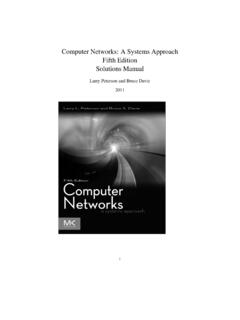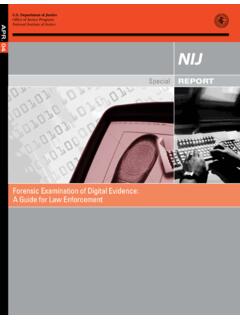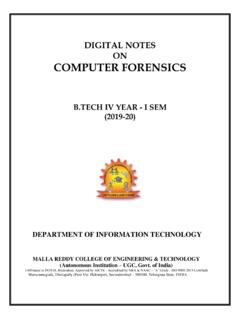Transcription of Digital Evidence and Computer Crime, Third Edition
1 2011 Elsevier Inc. All rights reserved. Page 1 Digital Evidence and Computer crime , Third Edition INSTRUCTOR S MANUAL By Samuel Norris CONTENTS PART 1 Digital Forensics Chapter 1 Foundations of Digital Forensics 2 Chapter 2 Language of Computer crime Investigation 11 Chapter 3 Digital Evidence in the Courtroom 21 Chapter 4 Cybercrime Law: A United States Perspective 29 Chapter 5 Cybercrime Law: A European Perspective 38 PART 2 Digital Investigations Chapter 6 Conducting Digital Investigations 46 Chapter 7 Handling a Digital crime Scene 57 Chapter 8 Investigative Reconstruction with Digital Evidence 64 Chapter 9 Modus Operandi, Motive.
2 And Technology 71 PART 3 Apprehending Offenders Chapter 10 Violent crime and Digital Evidence 78 Chapter 11 Digital Evidence as Alibi 85 Chapter 12 Sex Offenders on the Internet 91 Chapter 13 Computer Intrusions 98 Chapter 14 Cyberstalking 106 PART 4 Computers Chapter 15 Computer Basics for Digital Investigators 113 Chapter 16 Applying Forensic Science to Computers 122 Chapter 17 Digital Evidence on Windows Systems 129 Chapter 18 Digital Evidence on UNIX Systems 139 Chapter 19 Digital Evidence on Macintosh Systems 151 Chapter 20 Digital Evidence on Mobile Devices 159 PART 5 Network Forensics Chapter 21 Network Basics for Digital Investigators 167 Chapter 22 Applying Forensic Science to Networks 176 Chapter 23 Digital Evidence on the Internet
3 185 Chapter 24 Digital Evidence at the Physical and Data-Link Layers 195 Chapter 25 Digital Evidence at the Network and Transport Layers 204 2011 Elsevier Inc. All rights reserved. Page 2 Chapter 1 Foundations of Digital Forensics Objectives On completion of this chapter, the student will - Recognize that there will be a Digital component in nearly every crime . - Be able to list some of the ways criminals use technology. - Recognize that increased use of technology increases Evidence . - Be able to define Digital Evidence . - Be aware of who is concerned with proper processing of Digital Evidence . - Recognize how Digital forensics has changed over time.
4 - Recognize the purpose and importance of best practices and accepted standards. - Be able to define Digital forensics. - Be aware of how Locard s Exchange Principle applies to Digital forensics. - Recognize the difference between class characteristics and individual characteristics. - Recognize that Evidence preservation is not an absolute. - Be aware of the steps to authenticate evidentiary data. - Recognize the need for documenting continuity of possession. - Be aware that hashing is an accepted method of establishing authenticity of data. - Recognize the need for objectivity on the part of the examiner. - Recognize that repeatability is a requirement of forensic soundness. - Recognize that Digital Evidence is volatile. - Be aware that Digital data is seen through one or more layers of abstraction.
5 - Recognize that Evidence dynamics will affect the state of the Digital crime scene. - Recognize the role that applied research plays in Digital forensics. Digital Evidence has come to play some part in virtually every crime . It would, in fact, be difficult to describe a crime scene that does not have a Digital element. Criminals have always found ways to use technology to their own ends, and Digital technology is no different. There is an upside to this the more Digital technology is used, the more likely that there will be resulting Digital Evidence . Digital forensics has undergone a number of changes from little more than looking at the hexadecimal values on floppy media to automated forensic tools that process terabytes of data in search of Digital Evidence .
6 Digital Evidence is the target of the forensic examiner, who pursues those Digital elements that support (or refute) a particular scenario. However, if the Evidence is to be used in court, the collection and processing must adhere to strict rules of Evidence . Therefore, it is important that everyone who is involved in the legal process law enforcement, attorneys, and the judiciary understands the concepts of Digital forensics and adheres to best practices and standard procedures. One such concept is Locard s Exchange Principle, which proposes that something is taken and something is left behind when someone enters a crime scene. This same is true with Digital 2011 Elsevier Inc. All rights reserved. Page 3 media. The substance of this exchange may possess either class characteristics or individual characteristics, the latter being more specific.
7 The concept that Digital Evidence should never be changed is desirable but not an absolute. There will be times where necessity dictates that Evidence , by being observed, has changed. This should, however, be noted in case documentation. The above notwithstanding, every effort should be made to properly copy the evidentiary media, and then to verify or authenticate the data collected so that the examiner can state the copied data is identical to the original. The accepted method for doing this is through hashing, which will be covered in a later chapter. Another issue is tracking the movement of the evidentiary data through the collection, storage, and analyzing processes. It is important establish a continuity of possession document that records when Evidence changes hands, with whom, and why.
8 Two other points central to forensic methodology are: objectivity and repeatability. The first, objectivity, means that the forensic examiner seeks the truth of events, not to prove that a suspect is the perpetrator. The second, repeatability, demands that, given identical media and processes, the same results should result. Challenges to the forensic process and Digital Evidence include: 1. The idea that the true data (magnetic patterns) is never observed, but rather, it is observed through some level of abstraction (the hexadecimal view of a file). 2. The concept of Evidence dynamics changes that creep into Evidence , either by accident or error, that change the data. Digital forensics methodology is constantly in flux the bad guys figure out some way to exploit a new technology and the good guys develop tools to capture and document the exploit.
9 That is the way it has always been and always will be. 2011 Elsevier Inc. All rights reserved. Page 4 Multiple Choice Questions 1. A valid definition of Digital Evidence is: a. Data stored or transmitted using a Computer b. Information of probative value c. Digital data of probative value d. Any Digital Evidence on a Computer 2. What are the three general categories of Computer systems that can contain Digital Evidence ? a. Desktop, laptop, server b. Personal Computer , Internet, mobile telephone c. Hardware, software, networks d. Open Computer systems, communication systems, embedded systems 3. In terms of Digital Evidence , a hard drive is an example of: a. Open Computer systems b. Communication systems c. Embedded Computer systems d. None of the above 4.
10 In terms of Digital Evidence , a mobile telephone is an example of: a. Open Computer systems b. Communication systems c. Embedded Computer systems d. None of the above 5. In terms of Digital Evidence , a Smart Card is an example of: a. Open Computer systems b. Communication systems c. Embedded Computer systems d. None of the above 6. In terms of Digital Evidence , the Internet is an example of: a. Open Computer systems b. Communication systems c. Embedded Computer systems d. None of the above 2011 Elsevier Inc. All rights reserved. Page 5 7. Computers can be involved in which of the following types of crime ? a. Homicide and sexual assault b. Computer intrusions and intellectual property theft c. Civil disputes d. All of the above 8. A logon record tells us that, at a specific time: a.










